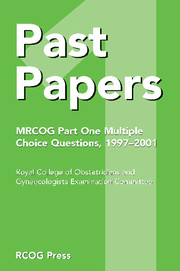Book contents
- Frontmatter
- Contents
- Introduction
- March 1997 – Paper 1
- March 1997 – Paper 2
- September 1997 – Paper 1
- September 1997 – Paper 2
- March 1998 – Paper 1
- March 1998 – Paper 2
- September 1998 – Paper 1
- September 1998 – Paper 2
- March 1999 – Paper 1
- March 1999 – Paper 2
- September 1999 – Paper 1
- September 1999 – Paper 2
- March 2000 – Paper 1
- March 2000 – Paper 2
- September 2000 – Paper 1
- September 2000 – Paper 2
- March 2001 – Paper 1
- March 2001 – Paper 2
- September 2001 – Paper 1
- September 2001 – Paper 2
- Index
September 2000 – Paper 1
Published online by Cambridge University Press: 05 July 2014
- Frontmatter
- Contents
- Introduction
- March 1997 – Paper 1
- March 1997 – Paper 2
- September 1997 – Paper 1
- September 1997 – Paper 2
- March 1998 – Paper 1
- March 1998 – Paper 2
- September 1998 – Paper 1
- September 1998 – Paper 2
- March 1999 – Paper 1
- March 1999 – Paper 2
- September 1999 – Paper 1
- September 1999 – Paper 2
- March 2000 – Paper 1
- March 2000 – Paper 2
- September 2000 – Paper 1
- September 2000 – Paper 2
- March 2001 – Paper 1
- March 2001 – Paper 2
- September 2001 – Paper 1
- September 2001 – Paper 2
- Index
Summary
1. The internal pudendal artery
A. leaves the pelvis through the lesser sciatic foramen.
B. lies on the medial wall of the ischiorectal fossa.
C. has a branch which pierces the perineal membrane.
D. gives rise to the middle rectal artery.
E. supplies the upper vagina.
2. The obturator artery
A. branches from the posterior trunk of the internal iliac artery.
B. passes through the greater sciatic foramen.
C. is crossed by the ureter.
D. supplies the hip joint.
E. may be replaced by a branch of the superior epigastric artery.
3. The adult pituitary gland
A. contains the paraventricular nuclei.
B. is related to the sphenoid bone.
C. lies inferior to the optic chiasma.
D. contains a pars tuberalis inferiorly.
E. is entirely ectodermal in origin.
4. The following statements about the adrenal glands are correct:
A. The adrenal glands are anterior to the diaphragm.
B. The right adrenal vein drains directly into the inferior vena cava.
C. The lymphatic drainage is to the superficial inguinal nodes.
D. The adrenal cortex contains chromaffin cells.
E. The adrenal medulla develops from mesoderm.
5. The anal canal
A. has an upper part which is innervated by the inferior hypogastric plexus.
B. has a lower part which is supplied by the superior rectal artery.
C. drains lymph to the superficial inguinal nodes from its upper part.
D. has its internal sphincter innervated by the inferior rectal nerve.
E. has a superficial part of its external sphincter attached to the coccyx.
- Type
- Chapter
- Information
- Past Papers MRCOG Part One Multiple Choice Questions1997–2001, pp. 141 - 151Publisher: Cambridge University PressPrint publication year: 2004



